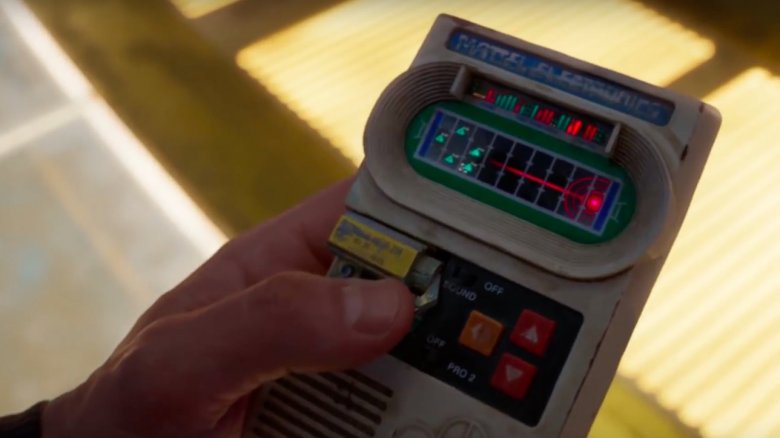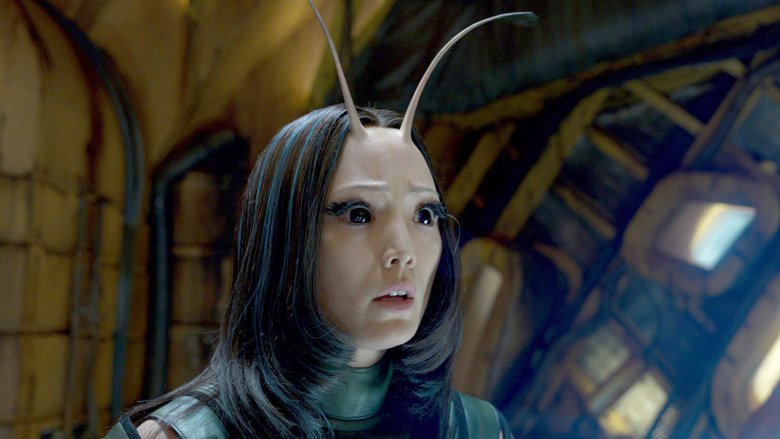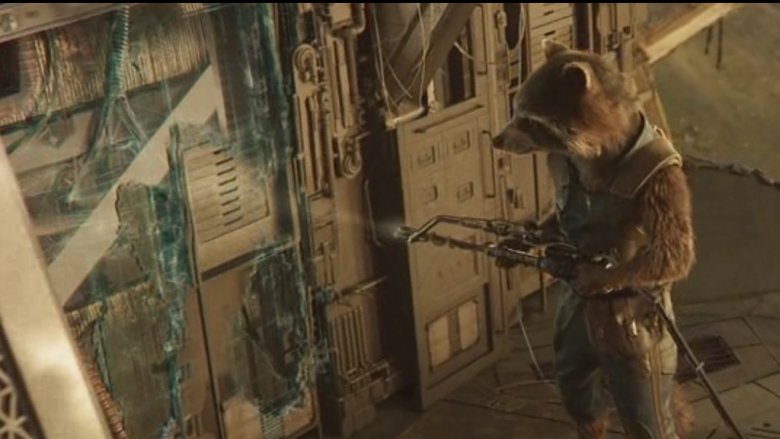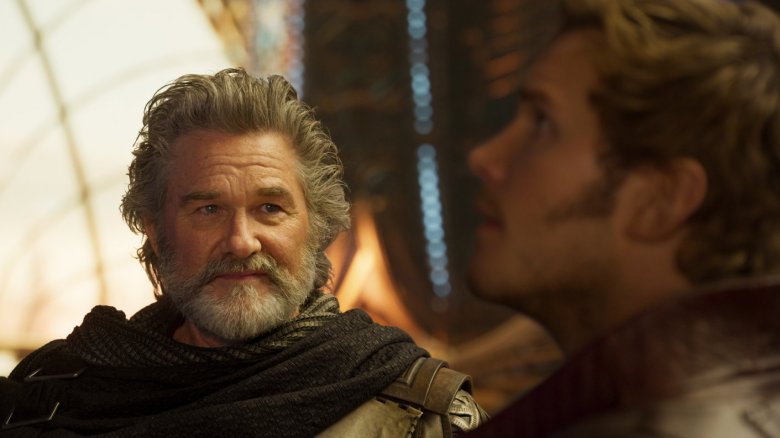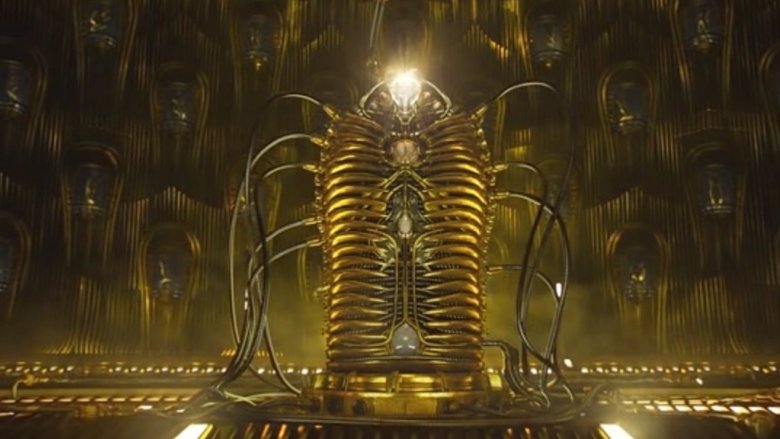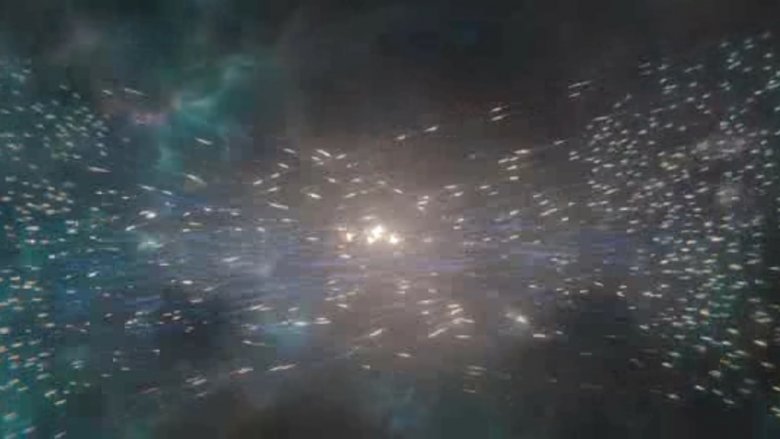Dumb Things In Guardians Of The Galaxy Vol. 2 That Everyone Ignores
The buzzed-about sequel to Guardians of the Galaxy delivered on pretty much all the things fans loved about the first film and managed to move the story forward in a wild and imaginative way. The movie was pretty great, and stands as one of Marvel's most fun movies to date, but it still wasn't perfect.
There are some weird plot holes, quirky easter eggs, and continuity questions that still left us scratching our heads. Sure, we were having a blast and scratching our heads, but still — the dumb things remain.
So here are all the dumb things in Guardians of the Galaxy Vol. 2 that everyone ignores.
So how does Star-Lord's vintage Mattel football game actually work as radar?
A big part of Star-Lord's vibe is his affinity for technology from his youth on Earth — everything from his outfit to his technology has a distinct 1980s vibe. That even carries over to the tracking technology he uses in the film's opening as the team prepares to face off against the giant Abelisk monster. Quill whips out a tracking device that is absolutely a repurposed, vintage Mattel football video game, which has been rewired to work as a tracking device of some sort. This thing raises so many questions though. Where did it come from? Did the toy happen to be in Quill's backpack when he left Earth as a kid? Did he acquire it somehow along the way? Who turned it into an Abelisk-tracking radar? Does Peter Quill have the engineering and technical know-how to actually turn this 30-year-old toy into a piece of space technology. To that end, if you're making a tracking device, why not use something with an actual screen on it? Seriously, we're so in the weeds on this thing.
Ego's excuse for keeping Mantis around is annoyingly thin
Looking back to the comics, the character of Mantis has a long and storied history with the Guardians of the Galaxy. She's been an ally and team member at different times, and, with this sequel, director James Gunn looked to bring in some comic players that didn't make the cut the first time around. Fans were certainly pumped to see Mantis show up, but Gunn tweaked the continuity quite a bit to fit her in. In the movie, Mantis is basically working as an indentured adopted daughter to Ego, and her main function seems to be using her empathic powers to help him sleep at night.
But when you start pulling at the seams, that doesn't make a lot of sense. Ego is a celestial being, meaning he's been around for millennia. He's one of the most powerful beings in existence, and he needs an empath to help him sleep at night? Ego is basically a god. He can manifest bodies and an entire planet. We're supposed to believe he somehow lacks the ability to get a bit of shut eye along the way? Besides, how did he sleep in the thousands and thousands of years before Mantis came around? Then there's the fact that she's the only person who knows his nefarious plans, but he keeps her around anyway and lets her hang out with the Guardians to potentially spill the beans. It seems like a matter of Gunn just wanting to get the character into the film — and simply fitting her wherever he could find a slot.
Rocket has a magic spray gun than can rebuild a space ship
After the Guardians are almost destroyed in their battle with Sovereign's forces, they crash-land the Milano on a nearby planet to regroup. Part of the team goes with Ego to his planet, but Rocket and Baby Groot are left behind to effect repairs on the ship — and Rocket seems to be using a magic spray gun that literally restores entire walls and equipment when he sprays it. Just like that. What is this device? The most magical MacGuffin repair machine ever conceived? Is this just a commonplace piece of technology in the far corners of the galaxy? Spray guns capable of repairing literally anything you point it at? How does it know what to put where? We obviously wondered how Rocket could repair entire missing pieces of the ship ripped off and destroyed in the crash, and the answer is a magic spray gun. Forget 3D printers, we want one of these things.
Why was Ego not 1980s Hasselhoff?
It's made clear that Ego never returned to Earth after he left Peter's mother, and Peter's only memories of his home planet date back to the Walkman-rocking era of when he left. So why did Ego appear as old man, modern-day David Hasselhoff during the actor's brief cameo when Ego was shuffling through avatars while talking to Quill? A subplot in the film reveals Quill keeps a pic of Knight Rider-era Hasselhoff in his pocket, because he used to tell kids Hasselhoff was his secret father, because he grew up without a father figure. So wouldn't he appear as 1980s Hasselhoff instead of modern-day, old man Hasselhoff? The obvious answer is because they scored the former heartthrob for the cameo, but why not de-age him a bit? They clearly have the technology, made clear by the younger version of Kurt Russell in the early part of the film.
Ego's plan seems needlessly complicated
Ego's nefarious plan to father a child who will carry the celestial gene to help him power a universe-wide takeover makes some sense but not all that much once you start picking it apart. We learn he's been doing this for a very, very long time across various planets and eras — made clear by the cave full of bones from his former children. So obviously, this plan has failed pretty miserably for a very, very long time. At this point, why does he even have faith it could actually work? Wouldn't it just make more sense to expand his search to try and team up with another celestial to put together the juice to pull off this takeover? Or, heck, why not turn his sights on the uber-powerful Infinity Stones that have kept Thanos so busy the past decade? Those could certainly give him the power bump to pull off his plan, right?
So why did Ego give Peter's mom cancer? And why tell him?
Ego is still making his hard pitch for Quill to join him when he reveals he is the reason Quill's mother died so young, and so tragically, due to cancer. Ego gave her cancer — and then proceeded to tell Quill about it while still trying to woo him over to the dark side. But why on Earth would he actually come clean with this reveal? If he's seriously trying to gain Quill's trust, revealing he's the cause of one of the most traumatic moments in his life doesn't feel like the smartest strategy. More than that, why give her cancer at all? He alludes to it being so he wouldn't be tempted to return to Earth and see her again, but the more we learn about Ego, he seems like a raging sociopath. Also, if he's planning to kidnap Quill anyway and bring him to space, why bother going to the trouble to kill his mother at all? Nobody's going back to Earth anyway.
From a storytelling point of view, the decision seems to be driven more as a galvanizing moment to fully turn Quill against Ego, and establish Ego as a cut-and-dried bad guy, more than something that makes total narrative sense. Up to that point, Ego had proven smart enough not to do something so dumb.
Wait, if Stallone is Stakar, then who played Rocky in the MCU?
This one admittedly gets a bit meta, but bear with us. Back in Captain America: The Winter Soldier, we learn Cap is keeping a list of things he needs to check out while he catches up on the decades of pop culture. Among that list are major figures like Steve Jobs, grunge rockers Nirvana, and the Rocky film series. Of course, Sylvester Stallone plays Rocky in the beloved boxing film series, and, at the time, it was just a cool little easter egg. Things got a bit more complicated in Guardians of the Galaxy Vol. 2 though, when director James Gunn cast Stallone as the Ravager leader Stakar a year or two later. Now, Stallone is officially part of the Marvel Cinematic Universe. So, if Stallone is actually a space pirate in the MCU, then who the heck played Rocky in the MCU version of the film series? Is it Burt Reynolds? Or maybe Robert Redford? We're fascinated to know.
Nobody noticed that Ego attack on Earth?
The timeline of the Marvel Cinematic Universe has always been a bit on the fuzzy side, but Guardians of the Galaxy Vol. 2 throws a few more kinks into the mix. Namely: We get a glimpse of Ego's expansion and how it affects modern-day Earth, but the film is set just a couple of months after the first Guardians of the Galaxy, meaning this would've happened within the timeline of films like Captain America: Civil War and the ABC series Agents of S.H.I.E.L.D. So why didn't anyone bother to mention a giant alien goo engulfing half of Missouri? Sure, it's possible it might've gone unmentioned, but that certainly seems like the type of incident that would've garnered the attention of whatever is left of the Avengers, or S.H.I.E.L.D., or someone. Even mentioning it offhand as an easter egg would've been a nice nod to continuity. It's all supposed to be connected, right? This one seems like an obvious oversight.
Yondu can control his magic arrow without line of sight now?
Yondu's arrow was one of the coolest weapons in either Guardians of the Galaxy film, and the first movie featured an action-packed climax where Yondu whistles his arrow into action to take down a small platoon of enemy soldiers. That concept gets amped up to 11 in Vol. 2, with Yondu getting his fin back and using his magic arrow to take out literally the entire mutinous crew of his Ravagers ship. It's a huge, murderous, mayhem-filled scene — but how the heck can he control that arrow with pinpoint accuracy across the entire ship? We get a glimpse of some security monitors at one point, sure, but Yondu isn't parked in front of them controlling this thing for the entire attack. It's an amazing action set piece, there's no doubt, but it makes Yondu pretty much an unstoppable whistle machine. To that point, in the post-credit scene we see Kraglin trying to control the arrow when it turns a corner and he clearly can't control it by sense. So it seems line of sight would be required, right?
Wait, didn't we already see an Adam Warlock cocoon in the first Guardians?
The first Guardians of the Galaxy film was positively loaded with easter eggs, and keen-eyed fans took their time parsing through all the little details. One of those tiny nuggets? A man-sized cocoon in the Collector's collection of intergalactic loot full of space goodies. For comic fans, it was the spitting image of the one from Marvel Comics that birthed galactic player Adam Warlock. Well, when Gunn decided to actually introduce the idea of Adam Warlock in one of Vol. 2's several post-credit scenes, he had to retcon that easter egg — and he did. When answering fan questions, Gunn noted the cocoon spotted in the first film is an early version of the ones used by the Sovereign, which makes a lot of sense once they formally introduce the tech in the second film. So that cocoon was just a random one. It's that fancy gold one that holds the promise of Adam Warlock.
It introduced one of the biggest pieces of Marvel continuity in a throwaway gag
Looking to Marvel Comics continuity, the mysterious race of beings known as The Watchers are a critical piece of the world. They've been around for critical events across all of time, and, in Marvel's comics, the Original Sin event in 2014 focused on the murder of Uatu the Watcher. The Watcher's became a legit part of the Marvel Cinematic Universe in Guardians of the Galaxy Vol. 2 when it's revealed famed Marvel Comics creator Stan Lee has been secretly working as an informant for the Watchers across all of his cameos in all of the Marvel slate. It's a fun couple of scenes, and Gunn does a fantastic job of bringing the Watchers comic look to life, but it's also a critical moment for the MCU. The Watchers exist, and it opens up a host of storytelling options if Marvel ever wants to pursue them. Could Phase 4 or Phase 5 actually give us a live-action murder mystery on the moon, like Original Sin?
So why didn't the Sovereign just use their robo-ships to fight the Abelisk?
The big action set piece that pits the Guardians against the space monster known as an Abelisk was an amazing scene. It featured a huge battle, a lot of dancing Groot, and one heck of a cool creature. But why were the Guardians there in the first place? We're told the Sovereign hired the Guardians to fend off the creature, because they didn't want to risk any of their own people's lives in the battle. Which makes some sense. They seem to think a lot of themselves, and it jibes they would farm out any dangerous jobs. What makes less sense is when Rocket steals their batteries and they set out on pursuit with their remote-controlled ships. If they have an entire fleet that doesn't put any of their people at risk, why not just use them to mow down the Abelisk, instead of risking the job to a shady group of misfits like the Guardians?
How on Earth did the Milano survive that Sovereign onslaught?
Look, Star-Lord obviously has a very cool ship. The Milano is fast, slick, and even comes loaded with a tape deck for all your soundtrack needs. But is it also virtually invincible? The ship takes a pounding during the battle with the Sovereign's forces, which culminates with dozens upon dozens of ships firing point blank on the Guardians. The Milano takes a good bit of damage, but up to this point we've seen ships go down with a shot or two. So, seriously, how on Earth does the Milano survive this veritable onslaught of laser fire while still maintaining enough integrity to stumble toward a crash landing?
So that's how interstellar travel works in the MCU?
Rocket and Yondu make a whole lot of "jumps" to track down Quill and the team on Ego's planet, apparently hopping across the galaxy in a matter of face-bending minutes. We get a chance to see these interstellar gates open up, and for the first time, we finally received some explanation as to how interstellar travel works in the Marvel Cinematic Universe. With the Guardians poised to visit Earth and team up with Earth's Mightiest Heroes in Avengers: Infinity War, it makes sense Marvel would want to establish the basics of how all this works. The website Inverse posits the ships in the MCU are likely using wormholes to jump between different points, which will likely be used to explain how the Guardians show up to lend a hand when Thanos attacks. How long do you think until Tony Stark builds some comic-inspired deep space armor and taps into that jump tech himself?
